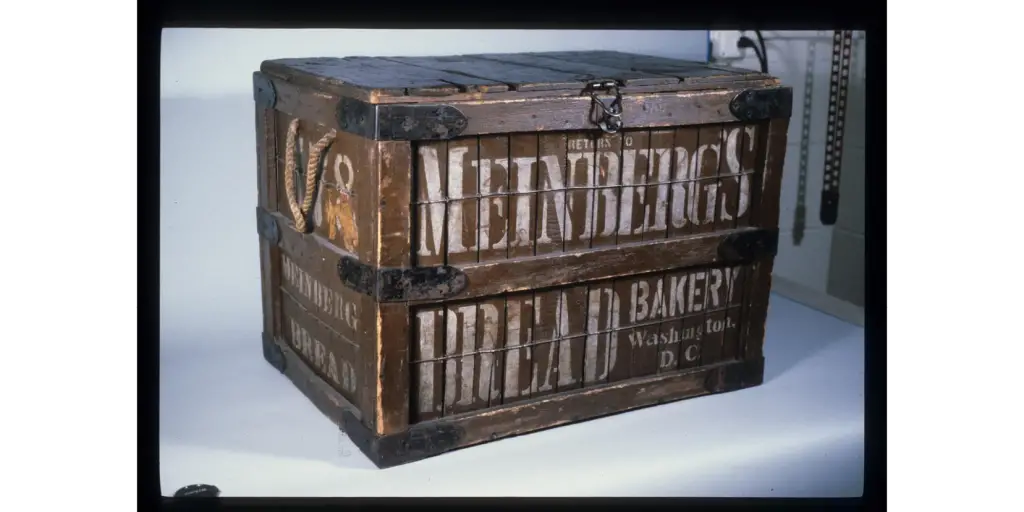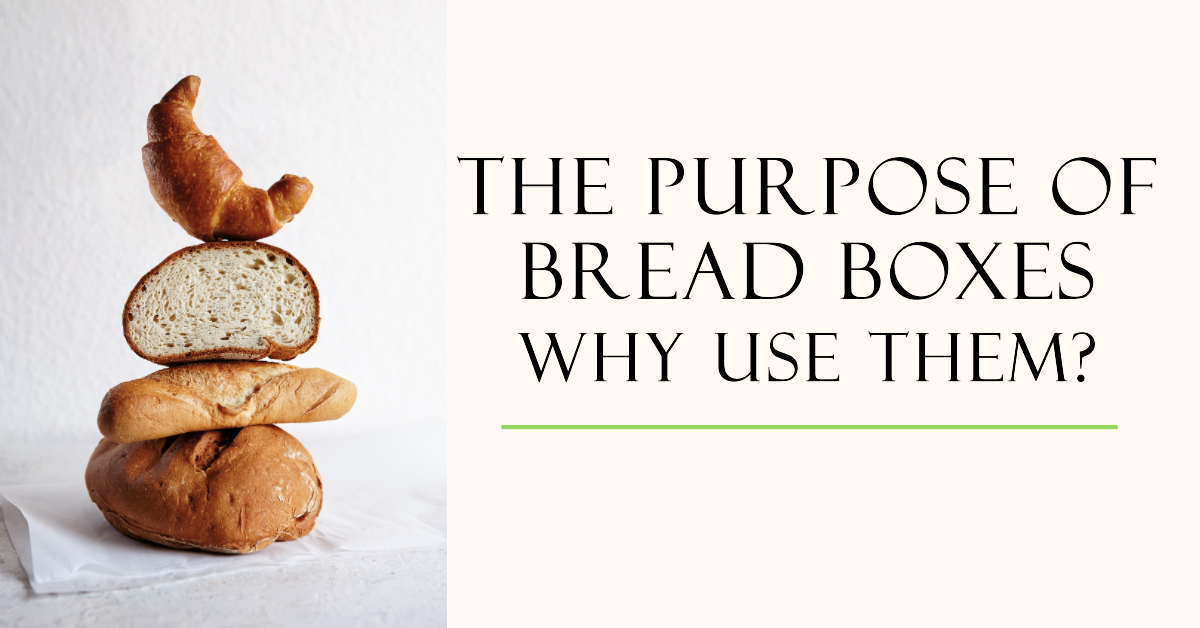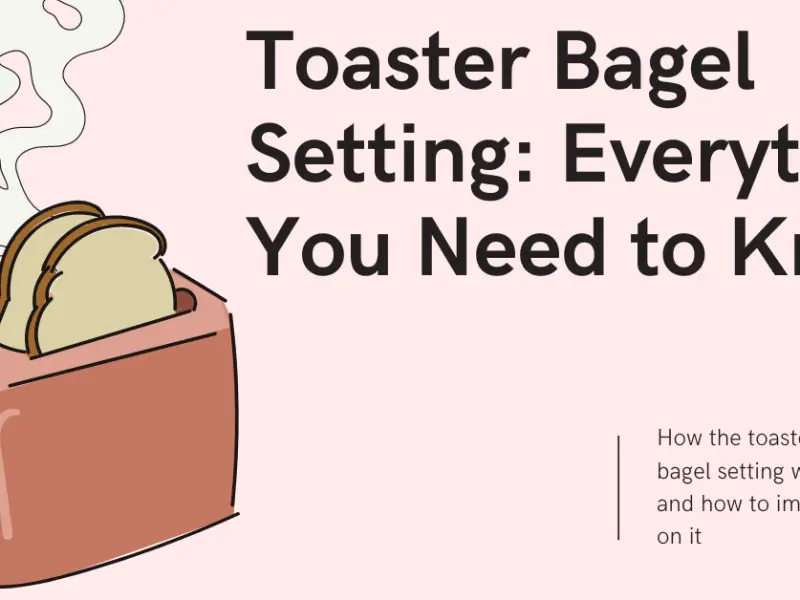I am a well-rounded expert with proficiency in several fields. My experience spans from being a dedicated chef and homemaker. As a passionate homesteader, I’ve honed my skills in sustainable living and animal care, ensuring a holistic approach to everything I undertake. Email me or Txt: (# removed due to spam, please email)
If you’re someone who loves freshly baked bread, you know how crucial it is to keep it fresh and delicious for as long as possible. That’s where bread boxes come in.
These handy containers have been around for centuries and have evolved to become an essential tool for bread lovers.
In this article, we’ll delve into the mystery of bread boxes, exploring their purpose, history, materials and designs, factors affecting bread freshness, role in reducing food waste, tips and tricks, and so much more.

The Purpose of a Bread Box:
The primary purpose of a bread box is to maintain the freshness and quality of bread. Bread boxes work by creating a microclimate that controls humidity, temperature, and air circulation.
These factors are essential for preventing mold growth, keeping pests away, and prolonging the shelf life of bread.
Additionally, bread boxes also help to keep bread from going stale too quickly. When bread is stored in a paper or plastic bag, the moisture inside the bread is trapped, causing the bread to lose its crispness and become stale.
Bread boxes allow for some airflow, which helps to regulate the moisture content of the bread and prevent it from becoming stale.
Overall, the purpose of a bread box is to keep bread fresh and prevent it from going to waste. By creating a microclimate that regulates humidity, temperature, and airflow, bread boxes are an effective way to prolong the shelf life of bread and reduce food waste.

A Brief History of Bread Boxes:
The practice of storing bread dates back to ancient civilizations, where bread was kept in earthenware jars or woven baskets.
However, it was not until the 18th century that the first recorded use of a bread box emerged, as people began to recognize the significance of proper bread storage.

Over time, bread box designs have continued to evolve, with a focus on improving efficiency, aesthetics, and innovation.
Today, bread boxes come in a variety of shapes, sizes, and materials, such as wood, metal, and ceramic, to name a few.
While bread boxes were originally designed to keep bread fresh and prevent mold growth, they have also become a decorative item in many modern kitchens.
Some bread box designs even incorporate additional features, such as cutting boards or built-in drawers, to further enhance their functionality.
In summary, bread boxes have come a long way since their inception in ancient civilizations.
From earthenware jars to modern-day designs, they have continued to play an important role in keeping bread fresh and have evolved to become a functional and stylish addition to any kitchen.

Bread Box Materials and Designs:
When it comes to bread boxes, there are a variety of materials and designs available to suit different preferences and needs.
Wooden bread boxes are a classic choice, offering a traditional and rustic look that can add warmth and charm to any kitchen.
The natural insulation of wood also helps to regulate moisture and temperature, which can contribute to better bread preservation.
For those seeking a more vintage aesthetic, metal bread boxes are an excellent option. They offer a touch of nostalgia and come in a range of colors and styles.
Metal bread boxes also provide a secure and durable storage solution that can withstand wear and tear.
In modern times, plastic and stainless steel bread boxes have become increasingly popular due to their durability, convenience, and ease of cleaning.
They are lightweight and typically come in a sleek, minimalist design that can complement any kitchen décor.
For those looking for advanced bread storage solutions, there are bread boxes with features such as temperature and humidity control.
These high-tech options are designed to create the optimal environment for bread preservation, helping to prevent spoilage and extend the shelf life of your bread.
The material and design of a bread box can greatly impact its functionality, appearance, and durability.
Whether you prefer a classic wooden box, a vintage metal option, or a modern plastic or stainless steel design, there is a bread box to suit your unique needs and style preferences.

Factors Affecting Bread Freshness:
Bread freshness is affected by several factors, including humidity and moisture control, air circulation, and temperature. Humidity and moisture can cause bread to become soggy or moldy, while lack of moisture can lead to bread going stale.
Bread boxes are designed to regulate these factors to create an optimal storage environment that helps to maintain bread freshness.
Air circulation is another critical factor that can affect bread freshness. Bread needs proper ventilation to stay fresh, as stale air can cause bread to dry out quickly.
Bread boxes with ventilation holes or slats can provide the necessary airflow to keep bread fresh.
Temperature also plays a crucial role in bread freshness. High temperatures can accelerate the growth of mold and bacteria, while low temperatures can cause bread to become dry and stale.
Bread boxes help to regulate temperature by providing insulation that can protect bread from extreme temperature fluctuations.
In addition to these factors, exposure to light can also affect bread quality. Exposure to light can cause bread to become discolored and stale, so it’s essential to store bread in a dark, dry place.
As you can see, a bread box fits all of these ideals perfectly, so it’s no surprise they are coming back in fashion.

The Science of Bread Storage:
Bread storage is a delicate process that requires a balance of humidity and temperature to preserve freshness and prevent mold growth.
Bread boxes are designed to maintain this balance by regulating the environment in which bread is stored.
The optimal humidity level for bread storage is around 60%. This level of humidity helps to prevent bread from drying out or becoming too moist, which can cause it to become stale or moldy.
Bread boxes are designed to regulate humidity by providing a sealed or semi-sealed environment that can retain moisture levels.
Temperature is another critical factor that affects bread storage. The ideal temperature for bread storage is between 60°F and 80°F. At temperatures below 40°F, bread can become dry and lose its texture.
Conversely, at temperatures above 80°F, mold growth can occur more quickly. Bread boxes are designed to regulate temperature by providing insulation that can protect bread from extreme temperature fluctuations.
The balance of humidity and temperature in bread storage is essential to slow down the rate of staling and mold growth. Staling occurs when bread loses moisture and becomes dry, while mold growth can occur in a humid environment.
Bread boxes work by creating an optimal environment that slows down the rate of staling and mold growth, allowing bread to stay fresh for longer.
In conclusion, the science of bread storage is all about maintaining the right balance of humidity and temperature.
By using a bread box, you can regulate these factors to create an optimal storage environment that slows down the rate of staling and mold growth, allowing bread to stay fresh for longer.

Bread Box Alternatives:
While bread boxes are a popular and effective way to store bread, there are several alternatives that can also keep bread fresh. Some of the alternatives to bread boxes include plastic bags, airtight containers, paper bags, and cloth wraps.
Each method has its pros and cons, so it’s essential to choose the one that best suits your needs and preferences.
Plastic bags are a common alternative to bread boxes. They are affordable, easy to use, and can help to retain moisture. However, plastic bags can also trap too much moisture, which can cause bread to become soggy or moldy. Additionally, plastic bags are not environmentally friendly and can contribute to plastic waste.
Airtight containers are another option for storing bread. They offer a sealed environment that can help to regulate humidity and temperature. Airtight containers are typically made of plastic or glass, and they come in various shapes and sizes.
However, airtight containers can also trap too much moisture, which can cause bread to become soggy.
Paper bags are a cost-effective and eco-friendly alternative to bread boxes. They allow for some airflow, which can help to regulate moisture levels and prevent bread from becoming stale.
However, paper bags are not as effective as bread boxes in regulating temperature, and they can also tear easily.
Cloth wraps are another eco-friendly option for bread storage. They are reusable and can help to regulate moisture levels. Cloth wraps are typically made of cotton or linen, and they come in various sizes.
However, cloth wraps may not be as effective as bread boxes in regulating temperature, and they may require more frequent washing to prevent mold growth.

Choosing the Right Bread Box:
When selecting a bread box, there are several factors to consider, including size, material, design, features, and price. These factors can impact the effectiveness, durability, and aesthetic appeal of the bread box.
Size is an important consideration when choosing a bread box. The size of the bread box should be large enough to accommodate the bread you typically buy, without being too large that it takes up too much counter space.
It’s also important to consider the size of your kitchen, as a bread box that is too large or too small may not fit well in your kitchen.
Material is another important consideration when choosing a bread box. Some popular materials for bread boxes include wood, metal, plastic, and ceramic. Wooden bread boxes are a classic and stylish option that can add warmth and charm to any kitchen.
Metal bread boxes are durable and easy to clean. Plastic bread boxes are lightweight and affordable, while ceramic bread boxes are a stylish option that can be used as a decorative piece in the kitchen.
Design is also an essential factor when selecting a bread box. Bread boxes come in a variety of styles, ranging from traditional to modern.
Some popular designs include roll-top, flip-top, and drawer-style bread boxes. It’s important to choose a design that not only looks good but is also functional and easy to use.
Features are another consideration when choosing a bread box. Some bread boxes come with advanced features like temperature and humidity control, cutting boards, and built-in drawers.
These features can add to the functionality and convenience of the bread box but may also increase the price.
Price is also a consideration when selecting a bread box. Prices can range from a few dollars to hundreds of dollars, depending on the material, design, and features. It’s important to choose a bread box that fits your budget and offers good value for money.
Some popular bread box brands and models include Brabantia, Wesco, and Typhoon. These brands offer a range of bread boxes in different materials, designs, and price points.

Bread Box Maintenance and Cleaning:
To ensure the longevity and effectiveness of your bread box, it’s essential to clean it regularly and maintain it properly. Proper maintenance and cleaning can also help to remove any stains or odors that may affect the freshness of your bread.
To clean your bread box, it’s important to follow the manufacturer’s instructions. Most bread boxes can be cleaned using a mild soap solution and a damp cloth.
It’s important to avoid using harsh chemicals or abrasive materials that can damage the surface of the bread box.
If your bread box has a wooden surface, it’s important to keep it well-oiled to prevent it from drying out and cracking. You can use food-grade mineral oil or beeswax to oil the surface of the bread box.
It’s important to avoid using vegetable oil or other cooking oils, as these can become rancid and affect the flavor of your bread.
If your bread box has any stains or odors, you can use baking soda to remove them. Simply sprinkle baking soda inside the bread box, leave it for a few hours, and then wipe it clean with a damp cloth.
Baking soda is an effective natural deodorizer and can help to remove any unpleasant smells.
It’s also important to store your bread box in a cool, dry place, away from direct sunlight or heat sources. This will help to prevent any damage or warping of the bread box’s surface, breaking any seals.
Proper maintenance and cleaning are essential to keep your bread box in optimal condition and ensure the freshness of your bread.

Bread Box Etiquette:
Proper bread storage techniques involve more than just putting bread in a box. To ensure the optimal freshness and quality of your bread, it’s important to follow proper bread box etiquette.
When placing bread in a bread box, it’s important to place it cut-side down on the surface of the container. This helps to prevent the bread from drying out and losing its texture.
Organizing the bread neatly in the container can help to prevent crushing or squishing of the bread.
It’s also important to avoid overloading the bread box with too much bread. Overloading the bread box can cause the bread to become overcrowded and stale quickly.
If your bread box is full, it’s best to store the remaining bread in a separate container.
Another essential aspect of bread box etiquette is to store different types of bread separately. This helps to prevent cross-contamination and can ensure that each type of bread retains its unique flavor and texture.
If you’re storing different types of bread in the same container, it’s best to wrap them separately in plastic or cloth to prevent them from touching.
Lastly, it’s important to keep your bread box clean and well-maintained. Regularly cleaning your bread box can help to prevent the growth of mold or bacteria, which can affect the freshness and quality of your bread.

Storing Homemade and Artisan Breads:
Homemade and artisan breads are delicious treats that require special care and attention when storing. These breads tend to have a shorter shelf life than store-bought breads, and they can quickly become stale or dry out if not stored properly.
To prolong the freshness of homemade and artisan breads, it’s essential to wrap them in a cloth or paper bag.
This helps to regulate the moisture level of the bread and prevent it from drying out. Avoid using plastic bags, as they can trap moisture and cause the bread to become soggy.
After wrapping the bread, it’s best to store it in a bread box with a moisture-control feature. Bread boxes with moisture-control features help to regulate the humidity level of the bread, preventing it from becoming too dry or too moist.
These bread boxes typically have ventilation holes or slats that allow for proper airflow and can be made of materials like wood, metal, or plastic.
It’s also essential to store homemade and artisan breads separately from other types of bread. Homemade and artisan breads have unique flavors and textures, and storing them separately can help to preserve their quality.
In addition to proper storage techniques, it’s important to consume homemade and artisan breads within a few days of baking. These breads do not contain preservatives, which means that they have a shorter shelf life than store-bought breads.

Bread Box Trends and Innovations:
Bread box design has come a long way over the years, with recent trends and innovations focusing on sustainability, convenience, and technology.
One of the latest trends in bread box design is sustainability. Many manufacturers are now producing bread boxes made from renewable materials like bamboo or recycled plastic, which are eco-friendly and sustainable.
These materials are also durable and can withstand frequent use, making them an excellent choice for bread storage.
Another trend in bread box design is convenience. Many bread boxes now come with built-in cutting boards or knife storage compartments, providing added functionality and convenience.
These features can save counter space and make it easier to prepare bread for sandwiches or toast.
Smart bread boxes are another innovation in bread box design. These bread boxes integrate technology like temperature sensors and automatic moisture control to offer the ultimate freshness and preservation.
Some smart bread boxes even connect to mobile apps, allowing users to monitor and control the storage environment remotely.
In addition to these trends and innovations, bread box design is also becoming more aesthetically pleasing, with a range of styles and designs to choose from. Bread boxes now come in a variety of colors, shapes, and sizes to suit any kitchen décor.

The Global Bread Box Market:
The bread box market is a global one, influenced by regional bread storage preferences and cultural influences. Bread box designs and market demand vary by region, with different materials, sizes, and features preferred in different parts of the world.
In recent years, the bread box market has seen significant growth, driven by rising awareness of the importance of proper bread storage and increasing demand for innovative and sustainable options.
Consumers are becoming more conscious of the environmental impact of their purchases, leading to a demand for eco-friendly and sustainable bread box options.
The North American market for bread boxes is one of the largest in the world, with a focus on traditional wooden bread boxes and innovative designs that incorporate technology like temperature and humidity control.
The European market is another significant player in the bread box market, with a preference for sleek and modern designs made from materials like stainless steel or glass.
The Asian market for bread boxes is also growing, driven by increasing awareness of the importance of proper bread storage and the rising popularity of artisanal bread.
In Japan, for example, bread boxes are often designed to accommodate the shape of traditional Japanese bread, while in China, bread boxes with built-in storage compartments for chopsticks are becoming increasingly popular.

Bread Box DIY and Upcycling:
Transforming old containers into bread boxes or customizing your bread box with creative designs is a fun and eco-friendly way to store your bread.
Repurposing bread boxes for alternative uses like organizing kitchen utensils or storing snacks is another way to extend their usefulness. Youtube is a great place to see what other people have done.

The Role of Bread Boxes in Reducing Food Waste:
Food waste is a significant issue globally, with millions of tons of food ending up in landfills every year. Proper bread storage is a simple yet effective way to reduce food waste and promote sustainability.
Bread boxes play a crucial role in reducing food waste by extending the shelf life of bread. By creating an optimal storage environment that regulates humidity and temperature, bread boxes can help to prevent bread from going stale or moldy.
This means that bread stays fresh for longer, reducing the amount of bread that is discarded.
By reducing the amount of bread that ends up in landfills, bread boxes also help to reduce the environmental impact of food waste.
When food waste decomposes in landfills, it produces methane gas, which contributes to climate change. By extending the shelf life of bread, bread boxes can help to reduce the amount of methane gas produced by food waste.
In addition to reducing food waste, bread boxes also promote sustainability by encouraging the use of reusable containers instead of disposable ones.
By using a bread box instead of disposable plastic bags or paper wrappers, consumers can reduce their environmental impact and promote sustainability.

Bread Box Tips and Tricks:
Proper usage of a bread box is essential for maximizing bread freshness and shelf life. Here are some tips and tricks for using your bread box effectively:
- Keep the bread box clean and dry: Regularly cleaning the bread box with a mild soap solution can help to prevent the growth of mold or bacteria. It’s also essential to keep the bread box dry to prevent excess moisture, which can cause bread to become stale or moldy.
- Adjust the humidity and temperature levels: Bread boxes with adjustable humidity and temperature levels can help to create an optimal storage environment for bread. If your bread box doesn’t have this feature, you can add a slice of apple or a piece of bread to the container to absorb excess moisture.
- Store different types of bread separately: To prevent cross-contamination and preserve the unique flavors and textures of different types of bread, it’s essential to store them separately in your bread box.
- Use a bread knife with a serrated edge: A bread knife with a serrated edge can help to prevent crushing the bread and preserve its texture.
- Optimize your bread box’s performance: You can also optimize your bread box’s performance by adding a layer of parchment paper or a cloth to the bottom of the container. This can help to absorb excess moisture and prevent the bread from sticking to the container.

Conclusion:
In conclusion, bread boxes are an essential tool for bread lovers looking to keep their bread fresh and delicious for as long as possible. With a variety of materials, designs, and features to choose from, there is a bread box to suit every need and preference. By following proper bread storage techniques, you can enjoy fresh, delicious bread every day while reducing food waste and promoting sustainability.



